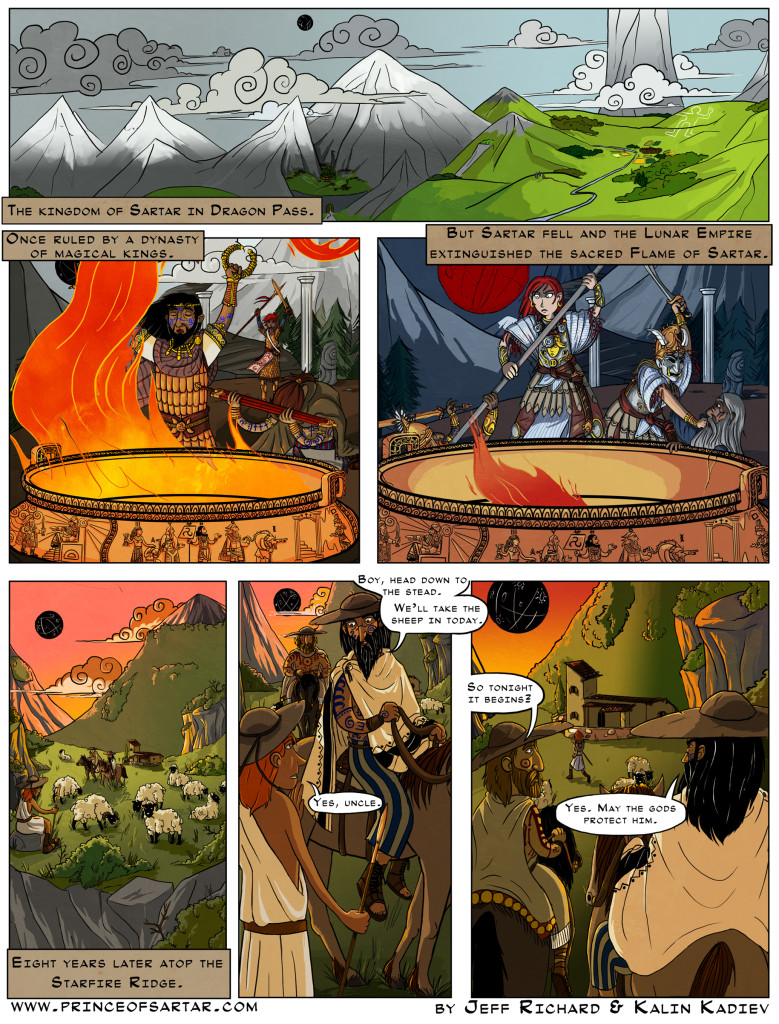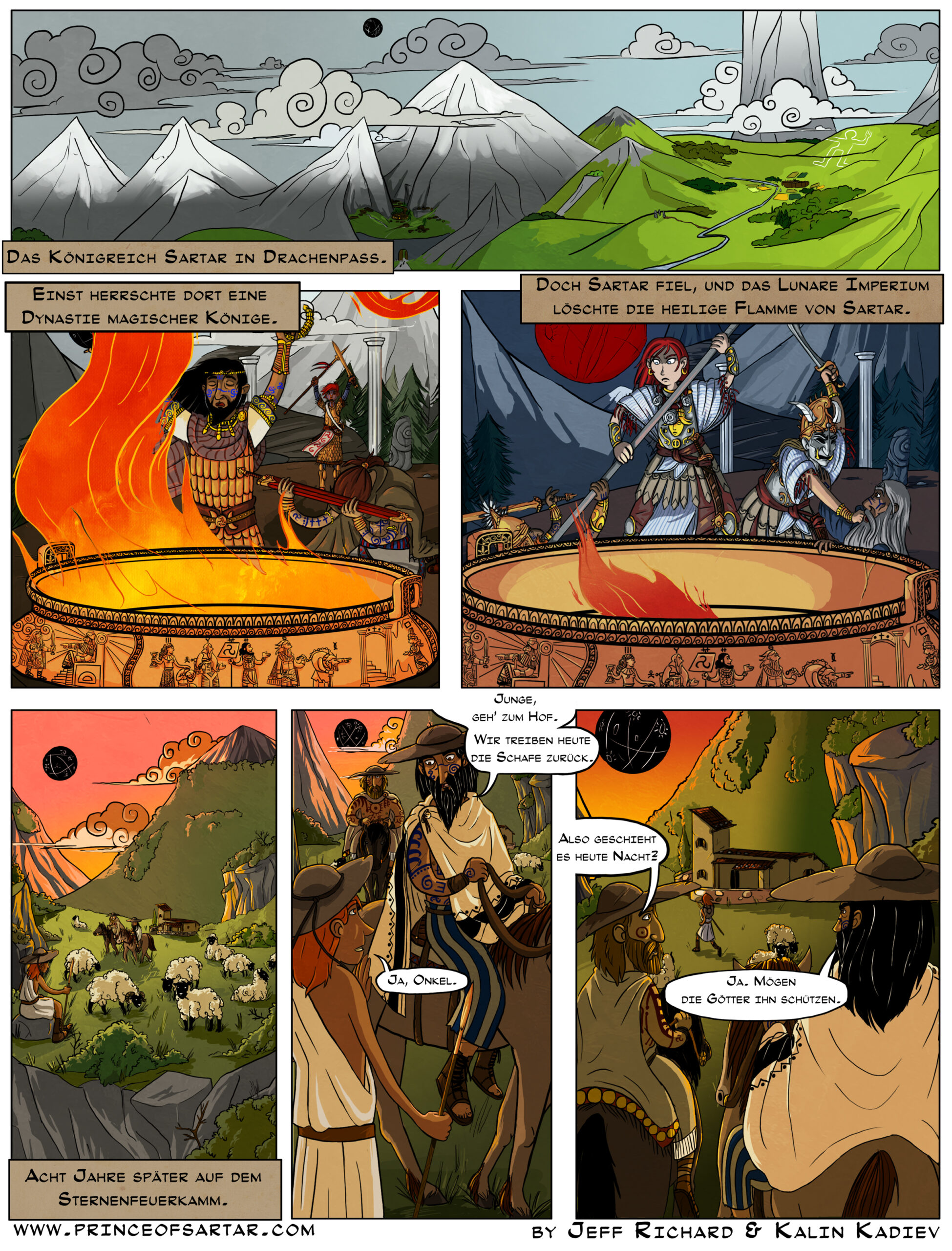
 | Chapter 1 – Initiation Kapitel 1 – Initiation Chapitre 1 – Introduction | 2 – The Uncles 2 – Die Onkel 2 – Les Oncles |  |


- Characters: Argrath, Jar-eel the Razoress
- Characters: Argrath, Jar-eel die Klinge
- Characters: Argrath, Jar-Eel la Tranchante
 | Chapter 1 – Initiation Kapitel 1 – Initiation Chapitre 1 – Introduction | 2 – The Uncles 2 – Die Onkel 2 – Les Oncles |  |
Art Direction
Panel 1.
TEXT: The Kingdom of Sartar in Dragon Pass
DESCRIPTION: A daytime panorama of Dragon Pass. This is a mountainous country, with steep and jagged peaks. Heavy clouds hang in the sky. At the base of the mountains we can see the great city of Boldhome, the capital of Sartar. On the right, a river flows through an alpine valley. There is a settlement by the river, with a large chalk outline of a man on the hill above it. In the background is Mount Kero Fin, the tallest mountain in Dragon Pass, so tall that its peak cannot be seen in this picture. The ever-present Red Moon hangs in the sky behind the clouds.
Panel 2.
TEXT: Once ruled by a dynasty of magical kings.
DESCRIPTION: It is daytime. King Saronil of the Sartar Orlanthi leads a ritual in Boldhome. He is wearing kingly attire, his arms raised high, a golden torc in one hand. He is standing at the great bronze brazier that holds the magical Flame of Sartar, a great roaring flame. It is artfully decorated with scenes from Orlanthi mythology. A warrior kneels beside him, head bowed with a sword held out in supplication. Another warrior stands in the background, holding their spear and sword aloft in a similar manner to King Saronil.
Panel 3.
TEXT: But Sartar fell and the Lunar Empire extinguished the sacred Flame of Sartar.
DESCRIPTION: It is now night time. The Flame of Sartar is sputtering out, and there is now a crack in the bronze brazier. Two Orlanthi are being murdered behind it; one of them is a warrior, but the other is a defenceless scribe. Their killers are Lunars. One of them is a member of the masked elite soldiers of the Full Moon Corps. The other is Jar-Eel the Razoress, hero of the Lunar Empire. Her face is totally calm even as she impales the warrior. They wield spears and scimitars. The Red Moon looms in the background.
Panel 4.
TEXT: Eight years later atop the Starfire Ridge.
DESCRIPTION: Argrath watches a flock of sheep, sitting on a rock and holding a short bronze spear. He is a slender young man with angular features. His bare arms lack tattoos, showing that he is still a child in Orlanthi society. The sheep are grazing by the edge of a cliff. He is being approached by two farmers on horseback, one of them his uncle. In the distance is a large rustic house, an Orlanthi stead. The sun is setting behind a mountain.
Panel 5.
DESCRIPTION: Argrath looks up at his uncle. His uncle is an older man, bearded, with blue tattoos on his arms and torso. The other farmer is in the background. He is also tattooed, but his tattoos are maroon.
DIALOGUE:
Argrath’s Uncle: Boy, head down to the stead. We’ll take in the sheep today.
Argrath: Yes, uncle.
Panel 6.
DESCRIPTION: The two farmers watch as Argrath walks down to the stead.
DIALOGUE:
Orlanthi Farmer: So tonight it begins?
Argrath’s Uncle: Yes. May the gods protect him.
What’s the Cerne Abbas Giant look-a-like?
That is Chalk Man, an earth Spirit that really has no place being there, but I had forgotten to check where he’s actually located. So now he’s near the Quivin Mountains.
Related Pages
- 2 – The Uncles
- 3 – The Underworld
- 4 – Meeting the Second Son
- 5 – Argrath Faces Evil
- 6 – Argrath the Man
- 7 – Argrath faces the Lunars
- 8 – The Wrath of Argrath
- 9 – Exile
- End of Chapter 1
Page Last updated: 2025-11-15 09:14:25
